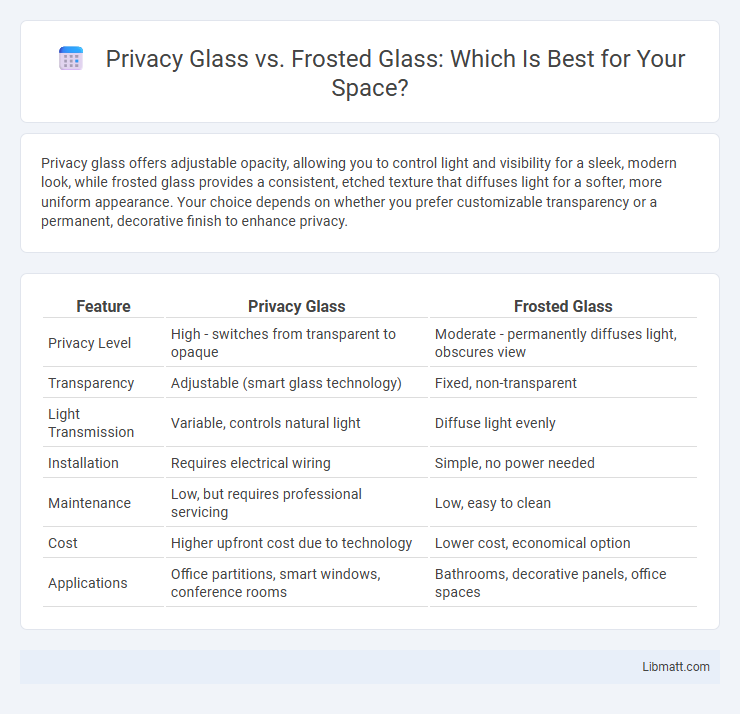Privacy glass offers adjustable opacity, allowing you to control light and visibility for a sleek, modern look, while frosted glass provides a consistent, etched texture that diffuses light for a softer, more uniform appearance. Your choice depends on whether you prefer customizable transparency or a permanent, decorative finish to enhance privacy.
Table of Comparison
| Feature | Privacy Glass | Frosted Glass |
|---|---|---|
| Privacy Level | High - switches from transparent to opaque | Moderate - permanently diffuses light, obscures view |
| Transparency | Adjustable (smart glass technology) | Fixed, non-transparent |
| Light Transmission | Variable, controls natural light | Diffuse light evenly |
| Installation | Requires electrical wiring | Simple, no power needed |
| Maintenance | Low, but requires professional servicing | Low, easy to clean |
| Cost | Higher upfront cost due to technology | Lower cost, economical option |
| Applications | Office partitions, smart windows, conference rooms | Bathrooms, decorative panels, office spaces |
Understanding Privacy Glass and Frosted Glass
Privacy glass uses a tinted or reflective coating to reduce visibility while allowing natural light, making it ideal for car windows and office partitions. Frosted glass diffuses light through a textured or sandblasted surface, obscuring details for enhanced privacy in bathrooms and conference rooms. You can choose based on the desired balance between light transmission and visual obscurity for your space.
Key Features of Privacy Glass
Privacy glass offers enhanced visibility control by darkening windows to reduce glare and block ultraviolet rays, making it ideal for vehicles and architectural applications. It maintains a sleek, transparent look while providing effective privacy and heat reduction, unlike frosted glass which diffuses light through a textured surface. Your choice depends on whether you prefer a subtle tint that preserves outward visibility or a more opaque finish for maximum obscurity.
Key Features of Frosted Glass
Frosted glass features a translucent surface achieved through sandblasting or acid etching, allowing light to pass while obscuring visibility for privacy. Its matte finish reduces glare and adds a decorative element suitable for office partitions, bathroom windows, and shower doors. The textured design enhances privacy without completely blocking natural light, making it ideal for spaces requiring both illumination and discretion.
Aesthetic Differences Between Privacy and Frosted Glass
Privacy glass typically features a smooth, often tinted surface that offers a sleek, modern look while maintaining clear outlines of objects behind it. Frosted glass presents a textured, etched appearance that diffuses light and creates a soft, opaque effect, adding a classic or decorative touch to interiors. The choice between privacy and frosted glass largely depends on desired light diffusion, visual clarity, and overall design aesthetic.
Installation Process: Privacy Glass vs Frosted Glass
Privacy glass typically requires replacing the existing window with pre-tinted or switchable glass panels, involving professional installation for proper fit and sealing. Frosted glass can be achieved either by applying a frosted film or sandblasting/acid etching the surface, allowing for more DIY-friendly or customized options. Installation time and cost tend to be higher for privacy glass due to specialized manufacturing and handling compared to the simpler frosting methods.
Cost Comparison: Which is More Affordable?
When comparing privacy glass and frosted glass, frosted glass generally offers a more affordable option due to its simpler manufacturing process and easier installation. Privacy glass typically involves advanced tinting or electrochromic technology, increasing both material and maintenance costs. Your choice will largely depend on budget constraints and desired functionality, with frosted glass being the cost-effective solution for static privacy needs.
Durability and Maintenance Considerations
Privacy glass, often made with laminated or tempered materials, offers enhanced durability and resistance to impact compared to frosted glass, which typically involves a surface etching or film application that may be more prone to scratches and wear over time. Maintenance for privacy glass is generally easier as its smooth surface can be cleaned with standard glass cleaners without compromising its opacity, while frosted glass requires gentle cleaning techniques to prevent damage to its textured finish. Choosing privacy glass can result in longer-lasting privacy solutions with less frequent upkeep efforts, especially in high-traffic or outdoor environments.
Applications and Best Uses of Each Glass Type
Privacy glass is commonly used in automotive windows and office partitions where maintaining clear visibility with reduced glare is essential, making it ideal for environments requiring unobstructed views but controlled privacy. Frosted glass excels in bathroom windows, shower enclosures, and conference rooms by diffusing light and providing complete visual obscurity, perfect for spaces needing high privacy without sacrificing natural light. Your choice depends on whether you prioritize visibility with privacy or total obscuration alongside light diffusion.
Energy Efficiency and Light Control
Privacy glass offers superior energy efficiency by minimizing heat transfer through its tinted or reflective coatings, helping to regulate indoor temperatures and reduce HVAC costs. Frosted glass diffuses light, providing soft, even illumination while maintaining privacy, though it may allow more heat to pass compared to privacy glass. Both options enhance light control, with privacy glass blocking glare more effectively and frosted glass maximizing natural light diffusion.
Choosing the Right Glass for Your Space
Privacy glass offers adjustable opacity, making it ideal for dynamic environments where control over visibility is essential, while frosted glass provides a permanent, uniform translucent finish that enhances natural light diffusion without compromising privacy. Selecting between privacy and frosted glass depends on your space's functional needs, such as whether variable light control or consistent opacity is preferred. Consider factors like room purpose, aesthetic goals, and budget to ensure the glass choice optimally balances privacy, style, and light management.
privacy glass vs frosted glass Infographic

 libmatt.com
libmatt.com